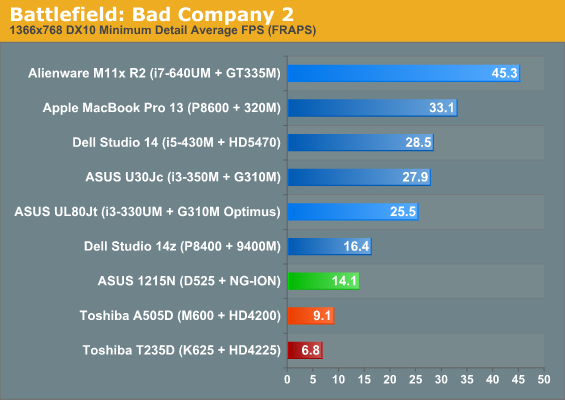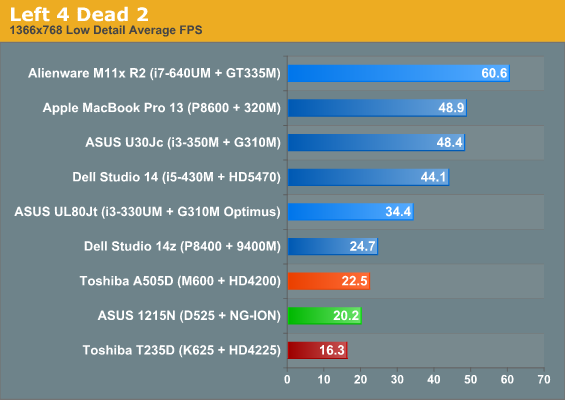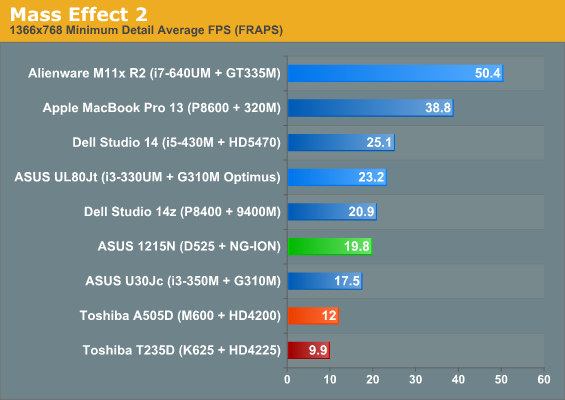ASUS EeePC 1215N: Bringing NG-ION to the 1201
by Vivek Gowri on November 25, 2010 12:00 AM ESTASUS Eee PC 1215N Gaming Performance
So, here we are with Next-Gen ION. The graphics chip identifies itself as ION, but it’s just an underclocked version of the NVIDIA G 210M/310M dGPU that was in some of our favorites like the UL80Vt. The GT 218 core has two versions for NG-ION netbooks, one for 10” platforms with 8 CUDA cores and one for larger platforms with the full 16 CUDA cores. The 1215N has all 16 SPs, so it’s going to be faster than the new 1015PN that has the Atom N550 and the 8 SP NG-ION chip.






Our gaming test suite is completely different now than it was when we tested the Eee PC 1201, so we can’t directly compare the two, but the 1215N is similar in that it gets blown out by its larger brethen, even though they are also running the same basic GT 218 core. Obviously, the G 210M and G 310M are clocked higher, but it’s still a sizeable difference. The ASUS U35 outdoes the 1215N by roughly a factor of two or three, except in STALKER and ME2. In our Call of Pripyat test, the NG-ION doesn’t actually have the ability to run the benchmark with anything other than static object lighting, so it’s not really on the same page as the other results. I re-ran the UL80Jt with the same settings just for comparison’s sake and got 96.1 fps, so again roughly double the 1215N. ME2 tends to be less CPU bound than some of the other benchmarks in our suite, so the drop in performance there is probably equally related to the lower GPU clock speed as it is the CPU bottleneck. Either way though, it’s simply not possible to run native resolution games at playable levels, even with bare minimum settings. To get playable framerates on most modern games, you will need to turn the resolution down to 1024x600 or so and just scale up to fullscreen.
But let’s stop comparing it to dedicated graphics cards—how does it do against some of the better integrated solutions? The NVIDIA 320M isn’t even a comparison worth talking about, since it’s about two times faster than the 310M. A bright spot for the NG-ION platform is that it outperforms the current AMD integrated graphics platforms in most of the tests, but again, given the AMD HD 6250 and HD 6310 (Ontario and Zacate, respectively) on the horizon, there’s going to be pressure on NVIDIA to boost the performance of their low end graphics solutions.










41 Comments
View All Comments
MeSh1 - Thursday, November 25, 2010 - link
" Intel has essentially left the Atom core the same since the launch in mid-2008" This is what happens when there is no competition.Alexstarfire - Thursday, November 25, 2010 - link
True, there aren't other netbooks without atom, but there are other CPUs to compete. Unfortunately they all suck. All of the "competitors" use more power, save for ARM processors. Not sure if they'll ever use ARM processors in netbooks though. Tablets and smartphones seem to promising for them.VivekGowri - Thursday, November 25, 2010 - link
No x86 license means no ARM netbooks. Qualcomm was trying to get the whole "smartbook" deal off the ground, basically just thinner netbooks running Snapdragon and either Linux, Chrome OS, or Android. They all sucked big time, then the entire segment got basically axed for tablets. Toshiba released this Tegra 2/Android smartbook, but it hit the market and basically disappeared, so that says enough about the segment.We'll see, I'm interested to see if AMD's impending release of Ontario can change anything, but the Ontario cores are clocked at a pitiful 1.0GHz (for the dual core, 1.2GHz for the single) so it might not beat Atom by too much. For single core apps, I'm thinking maybe a 20% boost in performance - whether this will be faster than Atom by enough to be usable is the question. But seriously, I would like for something (anything) to kick the Atom team into action. They basically created the netbook market with the release of Atom, but after that they've done nothing other than moving the graphics onto the CPU package. Every time I get a netbook, it's like "oh boy, Atom....again....greaaaaat" I want some interesting netbooks lol.
Eug - Friday, November 26, 2010 - link
Non-Atom netbooks already exist in 2010. The Acer listed in the review is arguably in this netbook/hybrid class, at 11.6" inches with a street price LESS than the Asus Atom/ION machine, but sporting a CPU that runs circles around Atom and which also has an integrated GPU (Intel 4500MHD) with full 1080p H.264 decode capability like NVIDIA ION provides.Hopefully 2011 will see more of these decently powered netbooks, whether it'd be with CULV Core 2 Duo class chips, or from Zacate, beginning in the sub US$400 price segment.
Actually, just as important as the CPU is the keyboard. Using 10" keyboards is utterly painful. Just one and a half inches more and you get a full-sized keyboard. It makes all the difference in the world, not for productivity apps, but for basic netbook-style internet consumption as well. It's much more pleasant typing an AnandTech comment on a full-sized keyboard. For this reason, any 10" model IMO isn't even in the running compared to the Asus 1215N, regardless of performance.
Terodius - Thursday, November 25, 2010 - link
you do realize Sony has a 13.3 inch vaio with core i7, nvidia discrete graphics and a full HD screen? I mean seriously... netbook on steroids? I consider 12 inches more of a ultraportable. with another extra inch you get the experience of a desktop replacement.monomer - Friday, November 26, 2010 - link
Did you seriously just compare a $500 netbook to an $1800 laptop?Well played.
jigglywiggly - Thursday, November 25, 2010 - link
THIS LAPTOP BE DISSAPOINTATOM SUX GTFO
damianrobertjones - Thursday, November 25, 2010 - link
What?erwos - Thursday, November 25, 2010 - link
I ordered a 1215N, but promptly returned it unopened after finding out online about the number of people who are breaking the flimsy power pin in the course of normal use. This is a very serious issue that needs to be addressed in the review.Scott_G - Friday, November 26, 2010 - link
Why wouldn't you just give it a try on your own, you can't always believe what people say on the Internet about defects. If you did believe everything then you wouldn't own anything tech related.